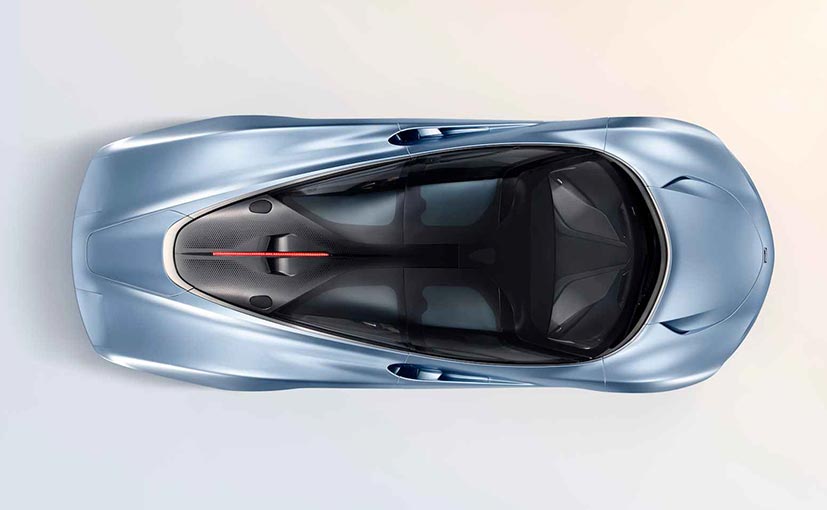McLaren Speedtail Unveiled

Highlights
McLaren Automotive has revealed the stunning Speedtail and it ushers in the next chapter in McLaren's Ultimate Series. The Speedtail is the first Hyper-GT from the British company and it can achieve the highest maximum speed of any McLaren to date, reaching 402 kmph The Speedtail all about contemporary craftsmanship, materials innovation and bespoke personalization. Just 106 units will be made and all are already reserved, at a price of 1.75 million Euros plus taxes.
Mike Flewitt, Chief Executive Officer, McLaren Automotive said "McLaren has never built a vehicle like the Speedtail before. As our first 'Hyper-GT', the Speedtail is the ultimate McLaren road car; a fusion of art and science that combines an astonishing maximum speed with an iconic central-driving position and a truly pioneering approach to bespoke personalization. A ground-breaking hybrid powertrain sits within a lightweight carbon fibre body reminiscent of sleek 'streamliners' that once set world speed records, while the luxurious three-seat cockpit offers a sublime combination of an incredible driving experience, unmatched individualism and innovative materials never seen before in a road-going vehicle."

The McLaren Speedtail can exceed the 391 kmph record peak speed of the legendary McLaren F1
As the most powerful and most aerodynamically drag efficient McLaren, the Speedtail can exceed the 391 kmph record peak speed of the legendary McLaren F1. It is also significant that this is the first of 18 new cars or derivatives that McLaren will introduce as part of its Track25 business plan.
The teardrop-shaped cockpit and aerodynamically optimized body are the foundation for the aerodynamic drag efficiency. There are innovative features such as carbon fibre front-wheel static aero covers, retractable digital rear-view cameras (in lieu of mirrors) and patented active rear ailerons further contributing to the ultra-low drag achieved.

Here you can see the teardrop-shaped cockpit and aerodynamically optimized body of the McLaren Speedtail
The Speedtail model is built around a McLaren Monocage carbon fibre structure and benefits from lightweight engineering throughout, including an all-carbon fibre body, aluminum active suspension and carbon ceramic brakes. The powertrain is a petrol-electric hybrid developing a combined 1,035bhp. The speed of 402 kmph is achieved in a unique Velocity mode, which has been developed specifically for the Speedtail. Velocity mode optimizes the hybrid powertrain for high-speed running while also tailoring the angle of the active rear ailerons. Additionally, the digital rear-view cameras can be retracted to further improve drag.
Furthermore, the Velocity Active Chassis Control can lower the Speedtail by 1.4 inches, leaving the highest point of the vehicle just 3.7ft (1,120mm) from the road surface. The hybrid powertrain enables an increase in vehicle speed regardless of engine rpm and the low weight of the Speedtail - only 1,430kg ads to this ability. The straight-line acceleration of the Speedtail sets a new benchmark for a McLaren, with 0-300 kmph achieved in just 12.8 seconds. McLaren's previous Ultimate Series hybrid, the P1, could reach this speed in 16.5 seconds. The Speedtail gets bespoke P-Zero tyres designed by Pirelli.

The McLaren Speedtail comes with space at the rear for two passengers
Inside the Speedtail the driver is positioned centrally in the cockpit, with seating for two additional passengers set at the rear. There is luggage space within both the nose and tail of the vehicle and a bespoke luggage set is available to every owner, the carbon fibre, leather and metalwork on the cases being matched to the interior specification of their Speedtail.
Andy Palmer, Vehicle Line Director, Ultimate Series, McLaren Automotive said, "As an Ultimate Series model, at the pinnacle of the McLaren range, the Speedtail pushes the limits of what is possible technically. Just as the McLaren Senna is the embodiment of extreme aerodynamic technologies and weight saving, so too is the Speedtail - but for this McLaren, the purpose was to achieve a new level of design sophistication and weight reduction in the pursuit of low aerodynamic drag, breath-taking acceleration and extreme velocity."

The McLaren Speedtail gets is a petrol-electric hybrid developing a combined 1035 bhp
Every body panel of the Mclaren Speedtail is made of carbon fibre and has been sculpted to reduce drag. The McLaren Speedtail is narrower than a McLaren P1, but more than half a meter (more than 1.6ft) longer, measuring nearly 5,137mm from nose to tail. The vertical ducts beneath the full LED headlights, are slender, their form meticulously tapered to minimize drag while still feeding sufficient cooling air into the LTRs (LowTemperature Radiators).
Airflow that doesn't enter the LTR ducts is directed over the bonnet of the Speedtail and enters two discreet upper front clam intakes. From here, it is ducted through the body and around the wheelarch before exiting out of the lower door vents. This engineering detail reduces the volume of air traveling around the side of the vehicle, which is prone to separation from the body and resulting turbulence. The residual airflow over the nose of the car is directed onto and over the windscreen by a cowling at the trailing edge of the bonnet. Engineered to completely encompass both the single-arm wiper and its operating mechanism, the cowling maintains a smooth flow transition across the front of the Speedtail and then over the roof towards the powertrain's 'snorkel' intake. This inlet, which provides the air intake for the internal combustion engine element of the petrol-electric powertrain, is set flush within the roof to reduce drag and cannot be seen when the McLaren Speedtail is viewed in profile. The required flow of air to the powertrain is maintained with two intakes that slope downwards, starting just behind the glass canopy. The intakes - which are split by the central high-mounted stop light - curve down into the engine cover before disappearing from view; a shorter, more aggressive intake would cause the air to separate from the surface and pass over the intake.














